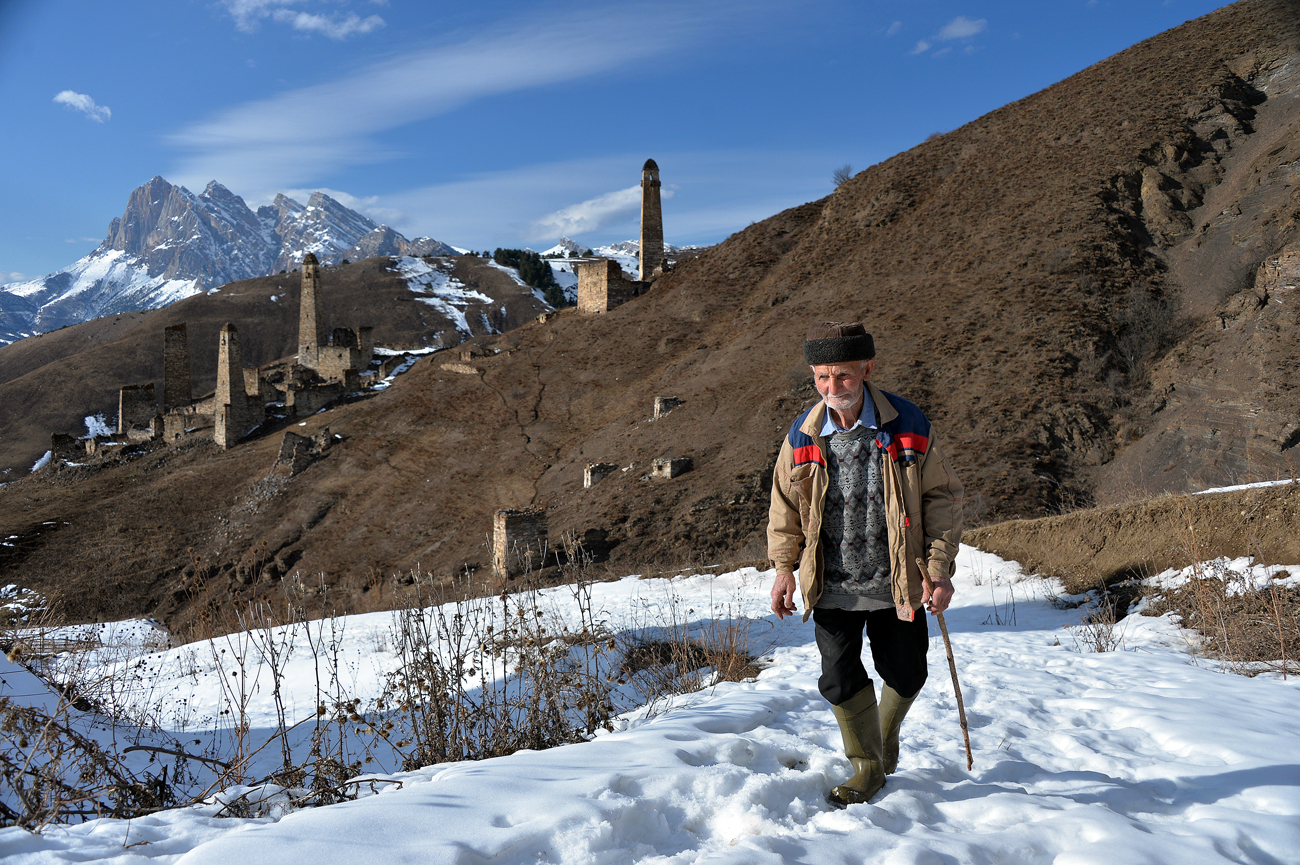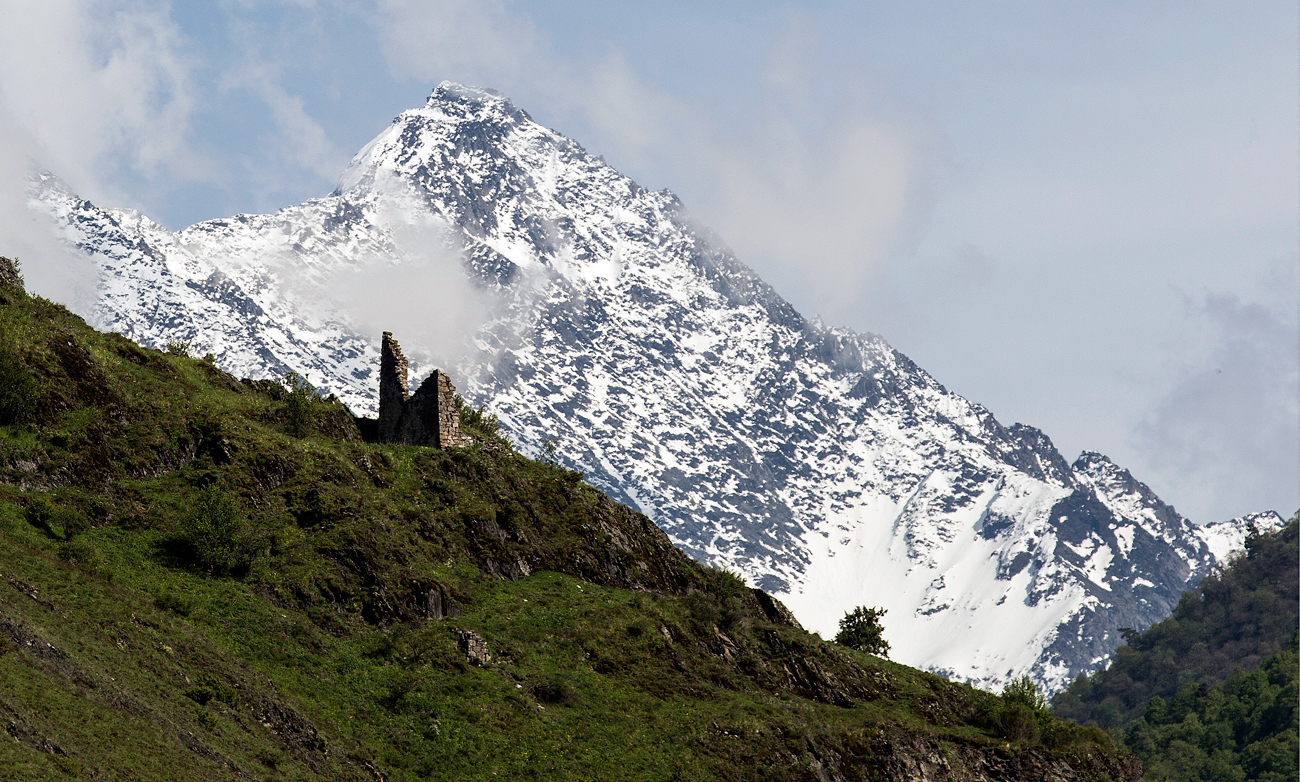The Ingush, Russia’s ‘people of the towers’

Isropil Chaniyev (born 1940), the only resident of a farmstead near the Pyaling historical-architectural tower complex in the Dzheirakh District of the Republic of Ingushetia.
Said Tsarnaev/RIA NovostiIngushetia’s Dzheyrakhsky District is a mountainous area, where altitudes vary from 4,000 to 6,600 feet (1,200 to 2,000 meters) above sea level. These mountains can tell you more about the Ingush people than any encyclopedia.
It is here that the famous Ingush family towers are located. There are about 200 spots in Dzheyrakhsky District where these medieval towers can be found. The biggest of them, Egikal, comprises over 40 towers. These mountains helped the Ingush to survive during the Mongol invasion of the North Caucasus in the 14th century. Back then, the Ingush fled from the valleys into the mountains and built their family towers, and next to them their houses, and family tombs nearby.
 The Caucasus Mountains as seen from Erzi nature reserve, Dzheirakh District, Ingushetia Source: Mikhail Japaridze/TASS
The Caucasus Mountains as seen from Erzi nature reserve, Dzheirakh District, Ingushetia Source: Mikhail Japaridze/TASS
Another historical event that has left an indelible mark on the fate of the Ingush people was their 1944 deportation by Stalin to northern Kazakhstan. Although accusations of collaboration with the Nazis and deportation affected other people of the North Caucasus too, it is believed that the Ingush suffered the most because upon their return and rehabilitation in 1957, their land had been partially occupied by their neighbors, the Ossetians. The bloody Ingush-Ossetian conflict that followed in 1992 resulted in many Ingush people having to move to other republics and settle in large Russian and European cities.
Ingush diasporas
“Nearly every Ingush has relatives in Moscow. There has been a large diaspora in the Magadan Region since during the Soviet years and in the 1990s, the Ingush worked there in gold mining and in timber processing. There are many Ingush working in northern Russia, in the oil processing sector,” says Khasan Nalgiyev, an ethnic Ingush, a businessman and the founder of the Tesham charity fund.
 "There are many Ingush working in northern Russia, in the oil processing sector,” says Khasan Nalgiyev, an ethnic Ingush, a businessman and the founder of the Tesham charity fund. Source: Press photo
"There are many Ingush working in northern Russia, in the oil processing sector,” says Khasan Nalgiyev, an ethnic Ingush, a businessman and the founder of the Tesham charity fund. Source: Press photo
There are about 700,000 Ingush in the world, with only 375,000 of them living in their native Ingushetia. There is no open data available on how many Ingush there are living in European countries, though local residents say that one of the most popular emigration destinations among the Ingush is Belgium. The biggest Ingush diaspora abroad is in Turkey, with 85,000 people.
Neither tradesmen nor craftsmen
“The Ingush continue to leave still: There is high unemployment here [over 30 percent, the highest in Russia] and wages are low,” says Ramzan Tsurov, a writer, the author of the anthem of Ingushetia and a tour guide in Dzheyrakhsky District.
“It also has to do with the national character: We are not good at trade, like the Armenians or Azerbaijanis are. We do not have a predominant craft… Here in the republic, the best developed sector is agriculture,” Tsurov continues.
![“The Ingush continue to leave still: There is high unemployment here [over 30 percent, the highest in Russia] and wages are low,” says Ramzan Tsurov, a writer, the author of the anthem of Ingushetia and a tour guide in Dzheyrakhsky District. Source: Press photo](https://cdni.rbth.com/rbthmedia/images/all/2016/11/15/ramzan_tsurov_b.jpg) “The Ingush continue to leave still: There is high unemployment here [over 30 percent, the highest in Russia] and wages are low,” says Ramzan Tsurov, a writer, the author of the anthem of Ingushetia and a tour guide in Dzheyrakhsky District. Source: Press photo
“The Ingush continue to leave still: There is high unemployment here [over 30 percent, the highest in Russia] and wages are low,” says Ramzan Tsurov, a writer, the author of the anthem of Ingushetia and a tour guide in Dzheyrakhsky District. Source: Press photo
The Ingush have always been rather poor, he says. It is their unity and solidarity that has helped them to get by.
“We have large families, a lot of relatives, everybody supports each other. For instance, the Ingush, like many other peoples living in the North Caucasus, love big houses. Ask me what I would choose: to go on a holiday to Thailand or to build a new gate? Of course, a new gate! One house can be built by a whole large family, from children to the elderly. And the construction can last years. Had it not been for that team spirit, we would not have survived…”
Tsurov explains that the Stalin-era deportation dealt a severe blow to the Ingush nation.
“A significant portion of the people died in exile. Those Ingush who returned had changed forever. There was a sad joke about an Ingush delegation going to the Kremlin with a petition: ‘Two lame men and one without an arm.’ Speaking in general, the beauty of the people was lost because of the reprisals, but now new generations are born, who, fortunately, do not have this ‘mark of pain’ on them.”
Keeping up with the Joneses – a national obsession
Dzheyrakhsky District is the hope of Ingushetia’s tourist industry. Not a long time ago, a skiing resort, Armkhi, was built here together with a dozen hotels for tourists. The inflow of tourists into the republic grows with every passing year. Since the start of 2016, Ingushetia has received 39,400 tourists, which is 24 percent more than in 2015. But the paradox is that there is a shortage of people willing to take up jobs in the services sector.
 Isropil Chaniyev (born 1940), the only resident of a farmstead near the Pyaling historical-architectural tower complex in the Dzheirakh District of the Republic of Ingushetia Source: Said Tsarnaev/RIA Novosti
Isropil Chaniyev (born 1940), the only resident of a farmstead near the Pyaling historical-architectural tower complex in the Dzheirakh District of the Republic of Ingushetia Source: Said Tsarnaev/RIA Novosti
“Our men do not like and don’t know how to work in the services sector,” says Tsurov. “It is their position of principle. We are not used to it. Working as a driver, a security guard, a train attendant is alright, but as a waiter – not so. In our cafes and hotels, the waiters are usually Ossetian women and the cooks are Azerbaijani men. Sometimes, a person is unemployed but still refuses to consider these vacancies.”
Tsurov reveals another peculiar feature of the Ingush people, the one that helped them create their impressive historical legacy – the family towers.
“We have this trait in our character – ‘to keep up with the Joneses,’” he laughs. “For example: ‘My neighbor has built a house with a beautiful gate, so I must have one that is no worse than his.’ That was how the family towers were built: It was very hard work, carrying those stones up in the mountains. These days, not all family towers have survived but in old times each family had its tower. Not a single family refused to build one.”
Read more: The Ossetians: From nomads and warriors to the artists of the Caucasus>>>
Subscribe to get the hand picked best stories every week
All rights reserved by Rossiyskaya Gazeta.
Subscribe
to our newsletter!
Get the week's best stories straight to your inbox